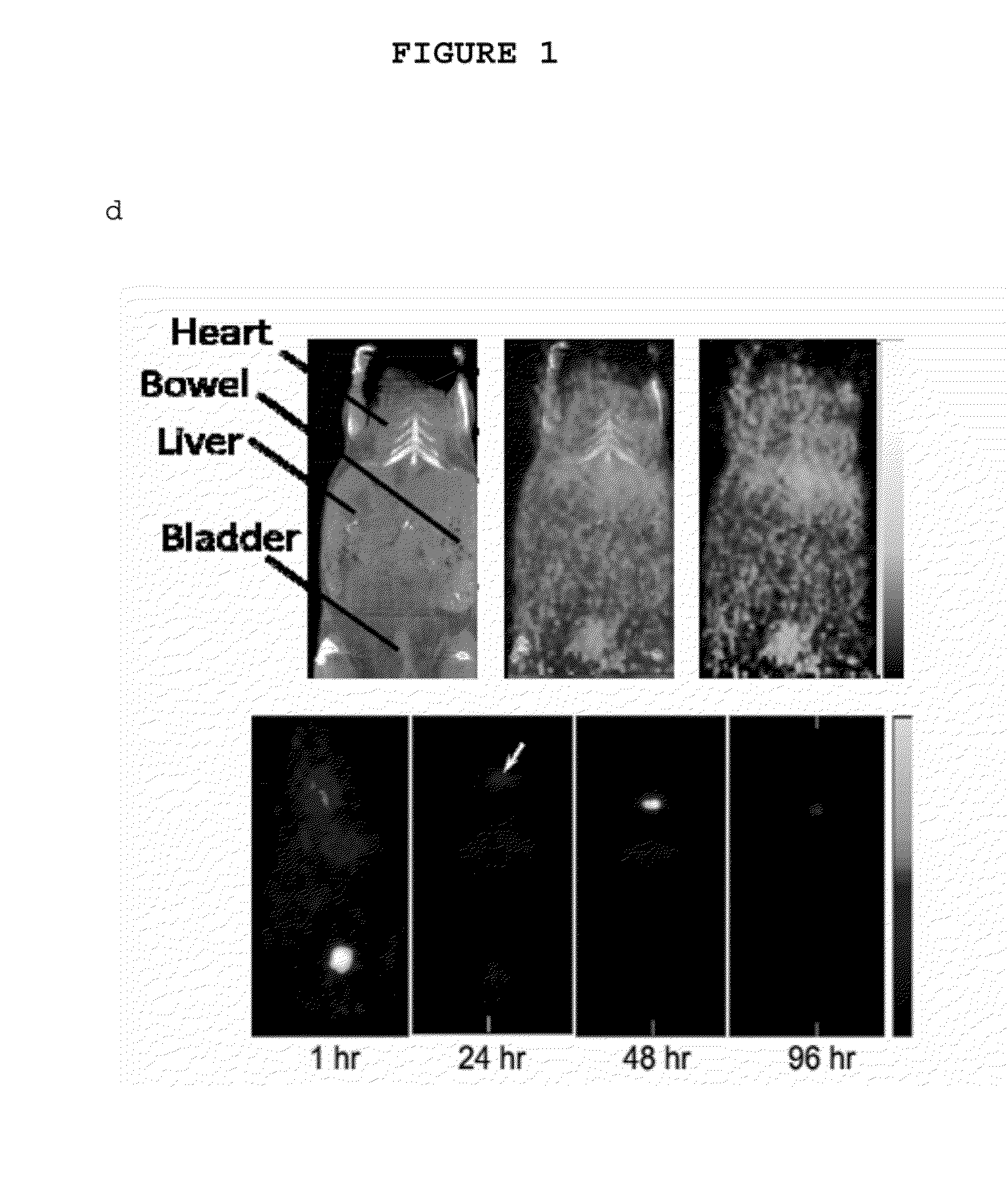Multimodal silica-based nanoparticles
a technology of fluorescence silica and nanoparticles, applied in the field of fluorescence silica-based nanoparticles, can solve the problems of limited imaging technology, disproportionate number of invasive biopsies, and limited evaluation of metastatic disease spread and tumor margins,
- Summary
- Abstract
- Description
- Claims
- Application Information
AI Technical Summary
Benefits of technology
Problems solved by technology
Method used
Image
Examples
example 1
Preparation and Characterization of PEG-Coated Nanoparticles
[0219]Nanoparticles containing an NIR-emitting dye (Cy-5) were synthesized and functionalized by PEGylation according to well-established protocols as disclosed in PCT / US2008 / 074894 and Stober et al. Controlled growth of monodispersed silica spheres in the micron size range. Colloid Interface Sci. 1968; 26:62-69. Ohnishi et al. J. Mol. Imaging 2005, 4:172-181. Cy5 malemide was reacted with a co-reactive organo silane compound, (3-Mercaptopropyl)tromethoxysilane to form a fluorescent silica precursor. This fluorescent silica precursor was co-condensed with tetraethylorthosilicate to form a fluorescent silica based core. A PEG-silane compound, with methoxy-terminated poly(ethylene glycol) chains (PEG, ˜0.5 kDa) Methoxy(Polyethy leneoxy) Propyl]-Trimethoxysilane, was added to the fluorescent silica based core to form a PEG coating on the core. PEG-coated nanoparticles were dialyzed to physiological saline (0.15M NaCl in H2O) t...
example 2
Renal Clearance of PEG Coated Nanoparticles
[0220]Fluorescent core-shell silica nanoparticles, having a hydrodynamic radius of about 3 nm, were synthesized. These nanoparticles were found to be in the 6-10 nm diameter range, as shown by dynamic light scattering (DLS) results (FIG. 1a). In vivo whole-body NIR fluorescence imaging of bare (no PEG coat) silica nanoparticles, on the order of 6-nm and 3.3-nm, in nude mice showed considerable renal clearance 45 min post-injection with a significant accumulation remaining in the liver (FIG. 1b). Eventual excretion into the enterohepatic circulation occurred during the ensuing 24 h. On the basis of these results, particles were covalently coated with methoxy-terminated poly(ethylene glycol) chains (PEG, ˜0.5 kDa), per protocols in PCT / US2008 / 074894, to prevent opsonization and further enhance particle clearance while maintaining a small hydrodynamic size. This treatment decreased liver retention and resulted in increased renal filtration int...
example 3
Fluorescent Silica Nanoparticles Conjugated with αvβ3 Integrin-Targeting Peptide (Melanoma Model)
[0223]To synthesize a multimodal (optical-PET) nanoparticle with high affinity for tumor marker αvβ3 integrin, cyclic RGD pentapeptide (RGDYC) was conjugated to the nanoparticle via a Cys-maleimide linkage. The tyrosine linker, Y, was used to subsequently attach a radiolabel. Male athymic nude mice were injected subcutaneously into their flanks with C6 rat glioma cells. At ˜0.5 cm in diameter, mice were IV-injected with either bare silica nanoparticles (FIG. 4A) or PEG-ylated RGD nanoparticles (FIG. 4B, ˜500 nm / kg). FIG. 4 shows the in vivo biodistribution in non-tumor-bearing and tumor-bearing mice using whole body optical imaging.
[0224]In vitro binding of targeted (RGD-bound) and non-targeted (PEG-coated) nanoparticles to αvβ3-integrin-positive human melanoma cell lines (M21) was investigated as part of a dose response study using flow cytometry (FIGS. 5A, 5B). Particle binding / uptake ...
PUM
| Property | Measurement | Unit |
|---|---|---|
| diameter | aaaaa | aaaaa |
| diameter | aaaaa | aaaaa |
| diameter | aaaaa | aaaaa |
Abstract
Description
Claims
Application Information
 Login to View More
Login to View More - R&D
- Intellectual Property
- Life Sciences
- Materials
- Tech Scout
- Unparalleled Data Quality
- Higher Quality Content
- 60% Fewer Hallucinations
Browse by: Latest US Patents, China's latest patents, Technical Efficacy Thesaurus, Application Domain, Technology Topic, Popular Technical Reports.
© 2025 PatSnap. All rights reserved.Legal|Privacy policy|Modern Slavery Act Transparency Statement|Sitemap|About US| Contact US: help@patsnap.com



